A two day Private Tour in North Norfolk looking to catch up with some of our regular and scarcer winter visitors. We were very lucky with the weather on Thursday, when it was dry with some unforecast dry intervals. On Friday, although we didn’t get anything like as bad as the Met Office yellow warning for heavy rain in the morning implied, it did drizzle on and off and ironically got slightly worse into the afternoon. It didn’t stop us though, and we got out and saw some great birds on both days.
We met this morning at Titchwell. The walk from the car park was fairly quiet but a large flock of Goldfinches flew over as we got to the Visitor Centre. We decided to head straight out down the main path, but scanning the ditches failed to produce a Water Rail. As we got out of the trees, a Water Pipit flew over calling and dropped down on to the former pool out on Thornham grazing marsh. We had a quick scan from further up, but there is too much vegetation on here now, and it had disappeared out of view.
A Marsh Harrier was circling out over the reedbed the other side, a female, so we stopped to watch it. Another was perched in the dead trees at the back and a third, this time a male, drifted over towards the path. We got a good look at it, a rather dark male, with patchy grey in the outerwing. A Cetti’s Warbler called from somewhere deep in the reeds and a second bird was singing half-heartedly a little further along.

A flock of Lapwings came in high over the saltmarsh and a short while later we spotted another small group coming high over the Freshmarsh. They were probably on the move, fresh arrivals from the continent coming in for the winter.
The water level on the Freshmarsh is very high now, and there are next to no islands still exposed. At least the wildfowl seem to appreciate it – there were quite a few ducks, including lots of Teal. We stopped to admire some of the smart drakes, in their finest breeding plumage now, with bright green and chestnut heads and creamy yellow patches under their tails. Several small groups of Brent Geese flew in from where they had been feeding, out on the saltmarsh.
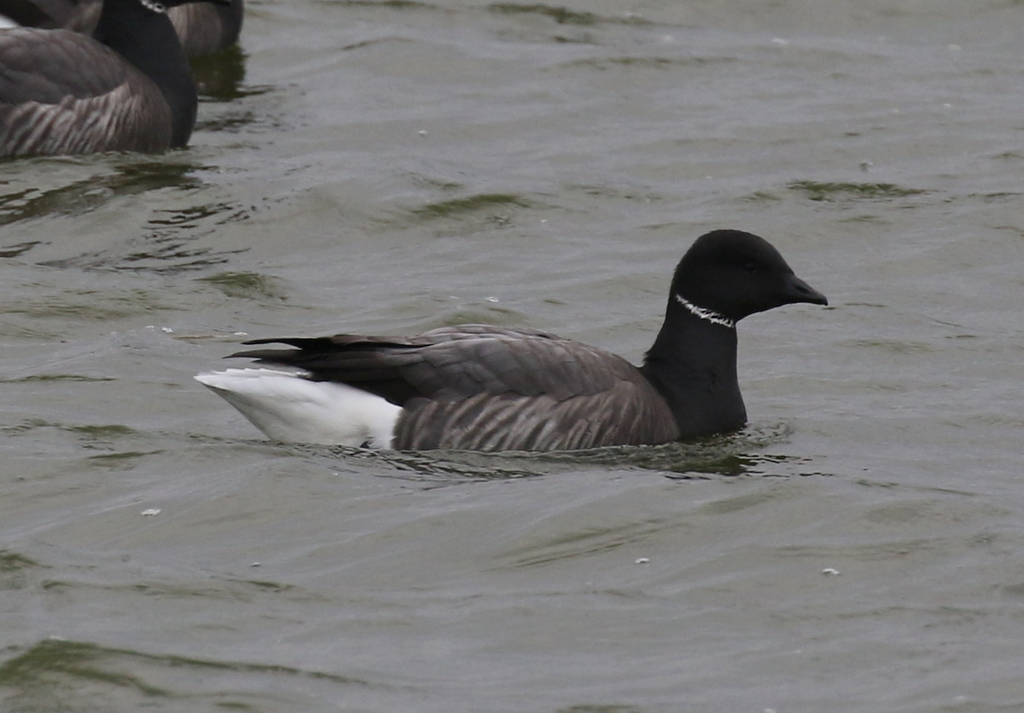
The weather was surprisingly good, much better than forecast, with some bright patches in the sky, so we decided to head straight out towards the beach first. We had just walked over the bank towards the Volunteer March, when we heard a Water Pipit calling behind us. We turned to see it circle round and drop down in the near corner of the Freshmarsh.
So we walked back over the bank, and found the Water Pipit feeding on the flotsam on the edge of the water, just below the Parrinder Bank. We had a great look at it through the scope, very clean white below with well-marked black streaks, and a clean white supercilium. Very different from the more familiar and rather swarthy Rock Pipit, two of which flew over the saltmarsh the other side, calling.
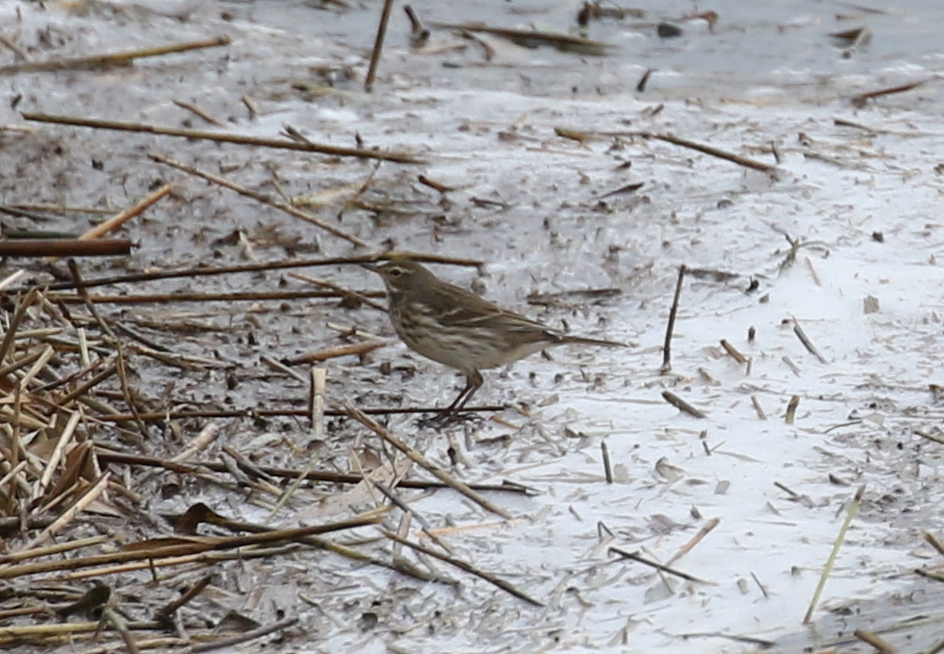
Even though the tide was in, it was not a particularly big tide today and there was still a good selection of waders on the Volunteer Marsh. There were one or two Common Redshanks in the channel below the main path and more birds at the far end, where the channel turns and heads away from the path.
We stopped to admire a smart Grey Plover in the scope. A couple of Knot were feeding nearby and a Dunlin flew in to join them, giving us a nice comparison of the three species side by side. Looking down the sides of the muddy channel, we could see one or two Curlew and more Redshank. Several more Knot were feeding in the taller vegetation out in the middle of the marsh, making them very hard to see.
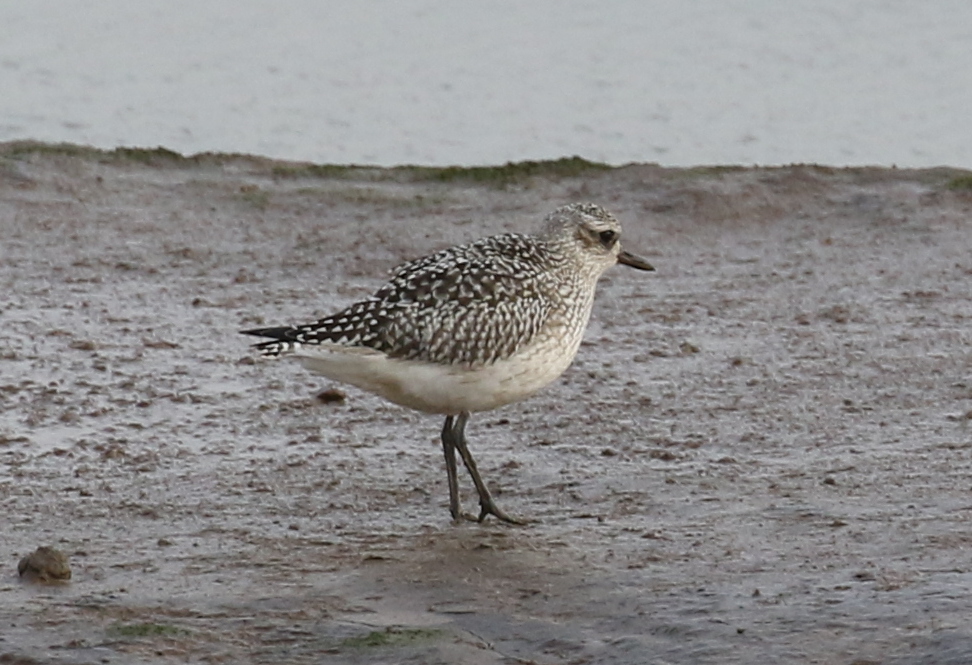
The Tidal Pool is now tidal again, with lots of exposed mud and islands, which means it is now a lot more productive. There was a nice selection of waders on here today. First up, we found a small roosting group of shanks – two Greenshanks, slightly larger and paler, very white below, together with two Spotted Redshanks. The latter were asleep, so we couldn’t get a look at their bills, but we could see the extensive white spotting on the wings and upperparts.
There were several Bar-tailed Godwits feeding on the small islands – and it was good to get a proper look at them through the scope. The spit at the back was packed with Knot and more sleeping Bar-tailed Godwits, and a mob of Oystercatchers were roosting on the island nearby.
A single Red-breasted Merganser was diving out in the middle of the water, unusual to see on here, amongst the several Pintails which were busy upending. We got the scope on the Pintails for a closer look – the drakes looking very smart now, in full breeding plumage, with their long, pin-like tails. There are more Little Grebes on here too now, including one which had climbed out onto one of the islands for a preen.
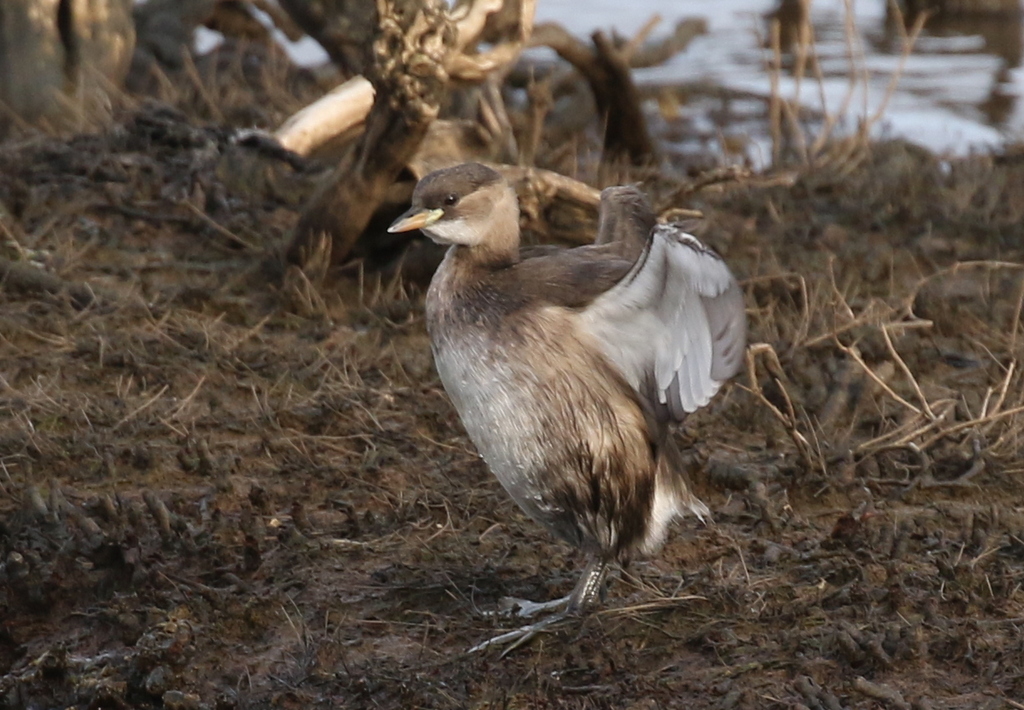
Continuing on to the beach, the tide was in. Apparently a couple of trawlers had just gone through and flushed most of the ducks. Those that were still here were a long way out. Scanning carefully, we found four drake Long-tailed Ducks, but they were very distant, and we could only see them when they flapped. There were lots more Red-breasted Merganser on the sea, off towards Scolt, including some smart drakes. And several Great Crested Grebes.
A Goldeneye flew in from the east. While we were watching it, another drake Long-tailed Duck flew past the other way, coming in from the direction of Thornham Point. The Goldeneye turned to follow it, and they both flew past us close inshore. It was a much better look at the Long-tailed Duck than the ones on the sea in the distance. As it flew past beyond the concrete blocks it looked for a second like it might land, but then it turned and flew back out towards the windfarm.
On our way back, we called in to Parrinder Hide. All the ducks were getting spooked by Marsh Harriers flying over the bank, so there were none close to the hide now. We did see more Water Pipits – probably at least two now. And there were several Lapwings on the one island which remains out above the water. Continuing on, we stopped by Island Hide to watch a pair of Reed Buntings which were feeding on the path. They flew up into the trees and perched there, flicking their tails and flashing their white outer tail feathers.
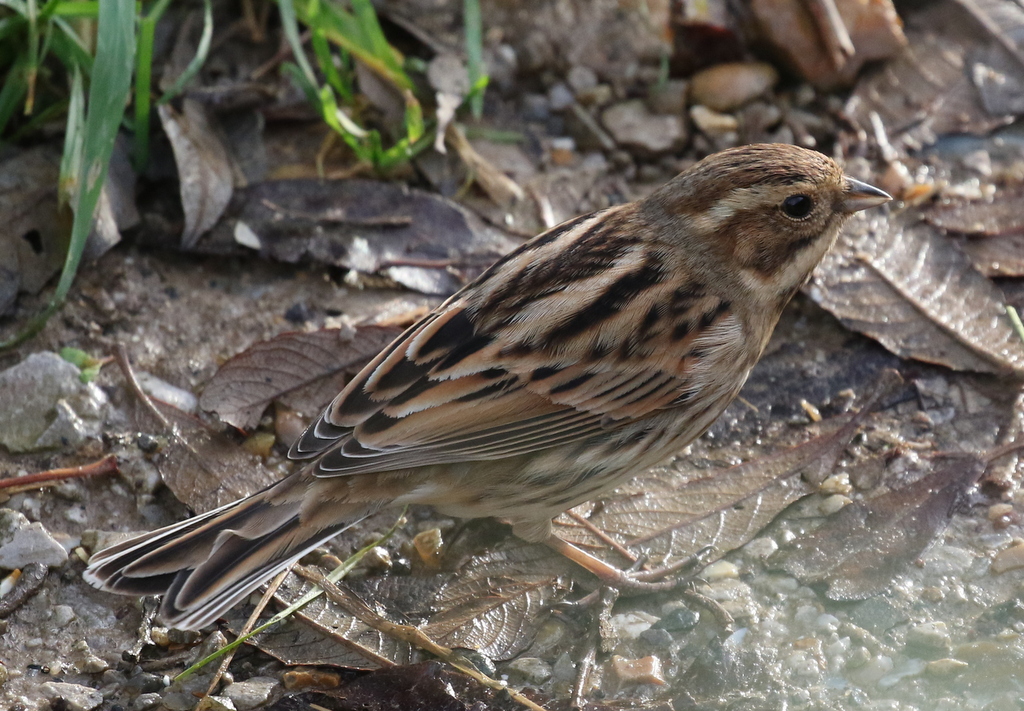
When we got back to the tree, there seemed to be lots of birds feeding along the path. There were several Chaffinches on the ground and tits in the bushes beside the path. As we stopped to look, someone called us over to say they had found one of the Water Rails down in the ditch. It was busy feeding, digging around in the wet leaves, and well hidden under the tangles of branches. There was a Chiffchaff in the bushes here too, and as we got back almost to the Visitor Centre, we stopped to watch a Goldcrest flitting around right beside us.
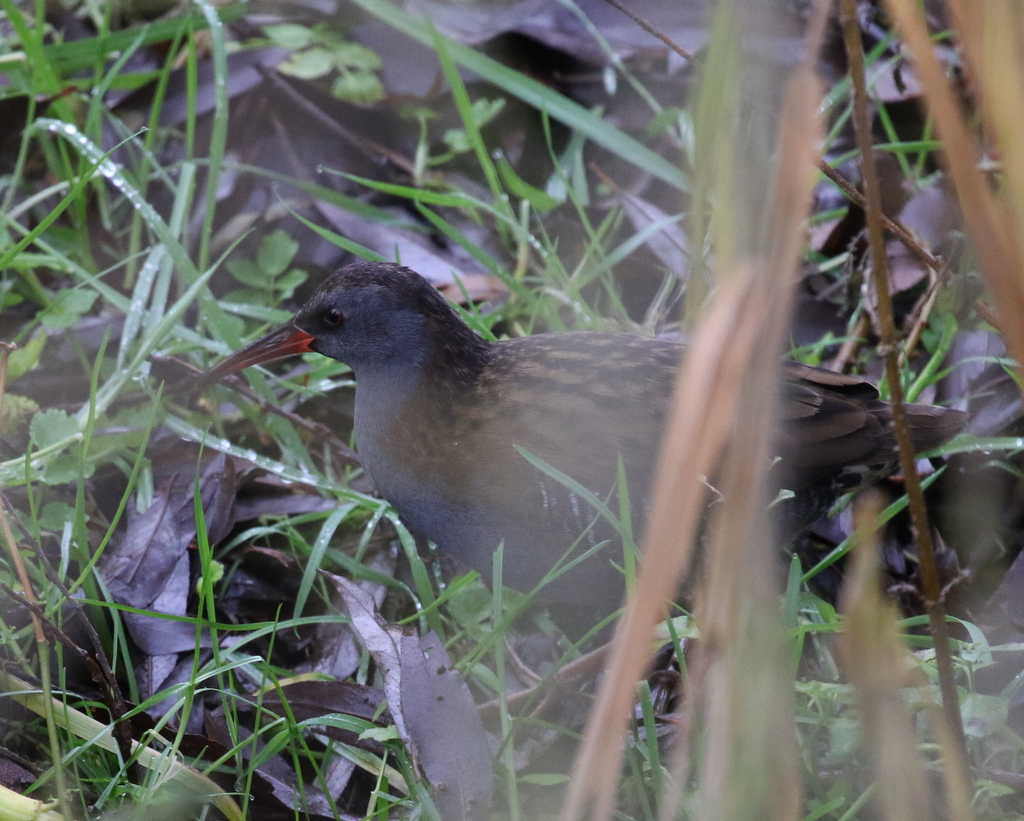
We had a break for lunch today – back at the Jolly Sailors in Brancaster Staithe. Afterwards, we drove further east along the coast to Warham.
It was fairly quiet as we walked up along the track. There were a few Blackbirds which flew out of the hedge ahead of us, and a Kestrel perched on the corner of the old barn. As we got to the end, a flock of Long-tailed Tits was working its way through the tops of the trees, and several Yellowhammers flew over calling.
We could hear the unmistakable sound of Pink-footed Geese approaching, and looked up to see several skeins flying in overhead from the fields. We watched them head out across the saltmarsh and drop down to roost on the flats beyond. From out on the coastal path, we could see a long line of Pink-footed Geese on the mud in the distance.
There were three Marsh Harriers way out over the beach when we arrived. Thankfully it wasn’t long before a Hen Harrier appeared too, a very smart grey male. It was a bit closer too, hunting back and forth over the back of the saltmarsh. We had a good view of it in the scope. Otherwise, there were several Little Egrets and Curlews out on the saltmarsh, plus a small group of Golden Plover and a well camouflaged Brown Hare.
We had a brief glimpse of a Merlin, too quick for everyone to get onto as it disappeared straight into some bushes. While we were scanning to see if we could find it again, what was presumably the same male Hen Harrier appeared, further over now, close to where the Merlin had been, but it too dropped down out of view.
Eventually the Merlin came out again, and we watched as it flew across fast and low over the saltmarsh. It was about to land on the top of a bush, but suddenly set off again instead, in pursuit of small group of Meadow Pipits. The Merlin chased one of the pipits higher and higher into the sky, both of them circling round and round. Then the Meadow Pipit dropped down vertically, with the Merlin in pursuit, before the two of them towered up again.
For a minute or so, the Merlin and the Meadow Pipit twisted and turned, up and down. Then suddenly the male Hen Harrier appeared below them, and as we watched it came up and grabbed the Meadow Pipit which the Merlin was chasing. Amazing! The Hen Harrier dropped down into the bushes with its prey and the Merlin disappeared off too, with nothing to show for its efforts.
It was a great display. The light was starting to go now, so we decided it was time to head for home.
We met again the following morning in Wells. The weather was not great – it was drizzling steadily – but at least there was no sign of the threatened yellow weather warning for heavy rain that the Met Office had belatedly decided we were going to get. At least they are reliably wrong with their forecasts!
We made our way down to the edge of the town, and pulled up in a gateway overlooking some fields. There were lots of Golden Plover huddled next to a flood in one of the fields, looking convincingly like clods of earth on first glance, and more Lapwings in another ploughed field beyond. A male Marsh Harrier came slowly past, hunting, and a rather dark Common Buzzard was perched on a post further back.
Scanning further across, we quickly found the Rough-legged Buzzard we had come to see, perched on the top of a bush back towards the car park. We had a quick look through the scope from here, just in case it decided to fly off. It was back on to us, but we could see its very pale head and just make out the white base to the tail visible between its folded wings. Then we drove round to the car park for a closer look.
From the edge of the car park, we got the Rough-legged Buzzard in the scope. It was a great view from here – we could see the distinctive blackish belly patch, contrasting with the pale head. Then it took off, flashing its black carpal patches, and flew round the back of the bushes out of sight.

We had been talking earlier about winter thrushes, so when we heard a Fieldfare call, we walked over towards the football pitch to see if we could find it. There was no sign of it at first, just a few Brent Geese flying round, then two thrushes flew up and landed on top of a tree at the back of the pitch. One was smaller than the other, a Redwing and Fieldfare side by side, a good comparison in the scope. We had also hoped we might find the Rough-legged Buzzard hunting round this side but we couldn’t see it from here.
Walking back round to where we had seen it earlier, we found the Rough-legged Buzzard back on the same bushes. We couldn’t resist another look through the scope, and we watched as it regurgitated a pellet, the indigestible remains of what it had been eating.
We could hear a Mistle Thrush singing behind us, so we turned to see two distantly on the wires over towards the town. A Meadow Pipit flew up and landed on some wires too, this time a bit closer. There were several Chaffinches in the hedge, and a Greenfinch landed in the top of a taller tree, where we could hear it calling. Eventually the Rough-legged Buzzard took off again and flew round out of sight once more, so we decided to move on.
Our next stop was round at Holkham. As we drove up along Lady Anne’s Drive, we stopped to admire a covey of Grey Partridge right next to the fence. They were rather damp, but it was a good view of them from the minibus.

We parked at the top of the Drive. After all the recent rain, there is a lot of water on the grazing marshes now. There were lots of Wigeon feeding out on the grass, with a few Teal, Shoveler and Mallard scattered round too. However, all we could find was just one distant Pink-footed Goose, which we got in the scope. There were several Redshank and a few Curlew out on the wet grass too.
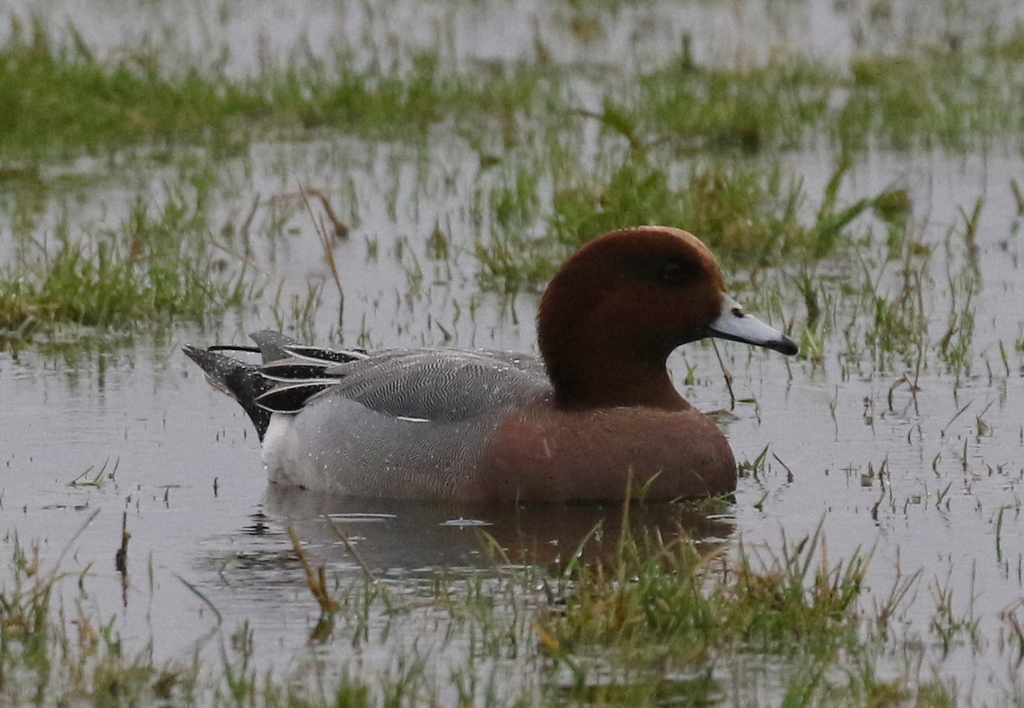
As it was still just drizzling, still no sign of the forecast heavy rain, we decided to brave the weather and walk out onto the saltmarsh. As we walked down the boardwalk the other side of the pines, we spotted a large flock of Brent Geese out in the middle feeding. More Brent Geese flew over from behind us and dropped down to join them. We walked over for a closer look.
One of the geese on the front of the feeding flock stood out – it was a little darker than the others, with a slightly more obvious white flank patch and extensive white collar. It is a Black Brant hybrid, a regular returning bird which has been coming back to exactly the same spot with the same flock of Brent Geese each winter for several years. Looking through the flock more carefully, we found a Pale-bellied Brent Goose too. The vast majority of our wintering Brent Geese are Dark-bellied Brents, which breed up in Central Siberia. The Pale-bellied Brent immediately stood out, with its much paler flanks and belly. A very interesting and instructive flock of geese!

We carried on along the path on the edge of the saltmarsh, out to the cordon. There was no sign of any Shorelarks here today, but it was quite wet, with lots of standing water. There are also only five so far this winter and they have been very mobile. We did find a nice flock of Snow Buntings though, feeding on the edge of the saltmarsh at the far end of the cordon. They were surprisingly hard to see until they flew up, flashing the white in their wings. There were about 50 Snow Buntings in total, some much paler than others, a mix of Scandinavian and Icelandic birds.
Continuing out onto the beach, we could see several Red-throated Divers just offshore, fishing just behind the breakers. We had some very good views of them in the scope – paler adults with their white faces and beady eyes, and a darker juvenile with duskier cheeks. We could see their distinctive upturned bills. A very pale, winter plumaged Great Crested Grebe was diving nearby.
Further out, we could see some very large rafts of Common Scoter, looking like long oily slicks until you looked through binoculars. A couple of Eider were out on the sea too, and several Red-breasted Mergansers including some smart spiky-haircutted drakes. Two distant Long-tailed Ducks flew across away to our left, but we lost sight of them round behind the dunes. Otherwise, there were surprisingly large numbers of Wigeon on the sea today, closer in, presumably having been flushed off the grazing marshes and sought the safety of the water out here.
We had planned to walk back along the beach, but it started to rain more heavily now so we decided to walk straight back to the minibus instead. It was already after midday by the time we got back (the forecast ironically had suggested the rain would ease in the afternoon!), so we drove round to Burnham Overy Staithe for lunch. On our way there, we could see large number of Pink-footed Geese in a potato field just beside the road, but there was nowhere to pull in for a closer look. It was nice to get in the warmth of The Hero and take the opportunity to dry out a little.
After lunch, we had a quick walk out along the seawall. The rain had eased off again, but it was still very grey and damp. The tide was in, and a single female Red-breasted Merganser was diving in the channel. A lone Common Scoter had walked up onto the shingle bank further back towards the dunes.
There had been Cattle Egrets out here still in the last couple of days, but there was no sign of any cattle now – they must have just been taken in. There were plenty of Little Egrets enjoying the many wet puddles in the fields.
There were lots more Wigeon out on the grazing marshes here. We had a nice view of a small group of Pink-footed Geese and Greylags together, feeding on the grass just below the bank. A good comparison and our best look at some Pinkfeet. A big flock of Brent Geese flew up from out on the saltmarsh over towards the dunes.

We stopped to scan from the corner of the seawall. There were about a dozen Barnacle Geese out here, very smart looking little geese, but most likely feral birds from Holkham. There were loads of waders out on the flooded grazing marsh too, Redshanks and Curlews, several little groups of diminutive Dunlin, lots of Lapwings, and a large flock of Golden Plover further out. It looked like it might be about to rain again, so we set off back to find the shelter of the minibus.
On our way back east, we stopped again at Holkham. There were not many geese feeding on the grazing marshes today – a few Greylags and a pair of Canada Geese with them. But scanning carefully, we eventually managed to find a small group of White-fronted Geese over at the back, in the mist. We could see their white fronts through the scope, when they lifted their heads.
We still had a small amount of time before we were due to finish, but we didn’t fancy venturing out in the rain again. We popped in for a quick look at the pools east of Wells, where we could have a scan from the bus. There was a single Little Egret out on one of the pools, but no sign of any other egrets here today. There was plenty of of water here, but it was rather quiet today. Something seemed to have been spooking the birds – the Teal were all in the grass and very flighty. The Lapwings were very jumpy too, and everything took off and flew round. Presumably a raptor had just been through.
It was time to call it a day now and head back to dry out properly. It had been a very enjoyable few days, despite the weather today, with a great selection of some of our finest winter birds.
















